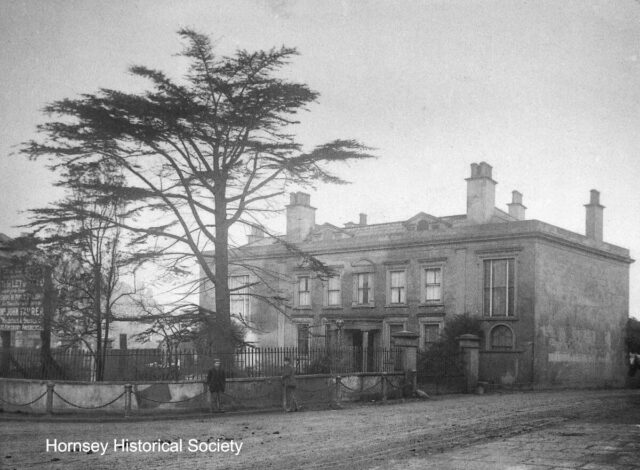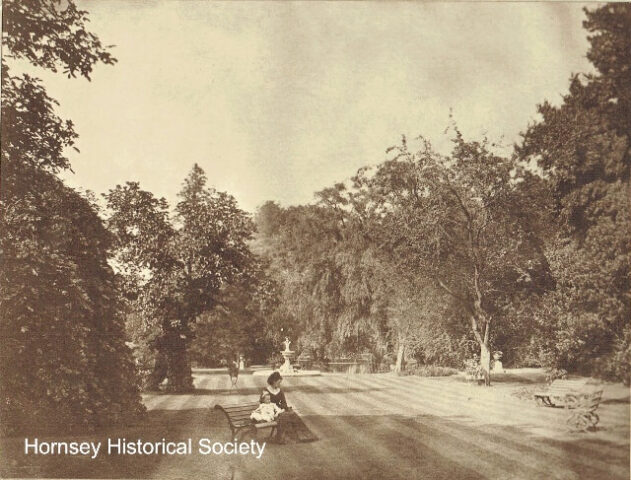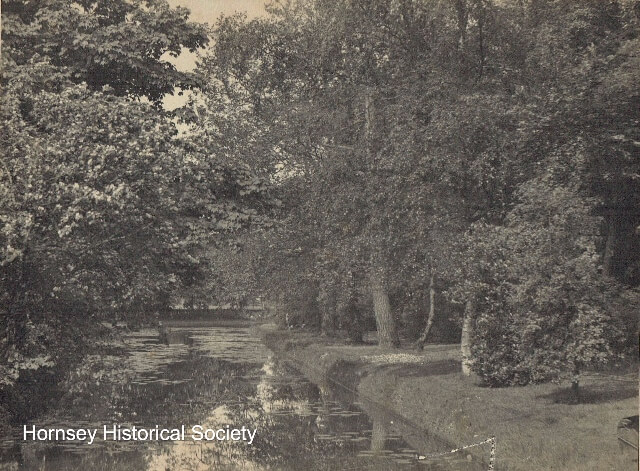This is the fourth article in the series on Lost Houses of the Hornsey area. It has been written by Alice Jenkins, a sixth form History student at Highgate Wood School, who has spent her summer holidays on work experience with the HHS Archive volunteers and who will shortly be applying to universities for admission in autumn 2022. HHS wishes her well.

Topsfield Hall stood in the centre of Crouch End as the manor house of the sub-manor of Topsfield from the late 1780s until its demolition in 1894. Though the site of where the house once was is now a terrace of shops, its name can be seen today in the nearby roads of Topsfield Parade, Topsfield Road, Topsfield Close and Topsfield Mews.
The Manor of Topsfield
Topsfield Manor, also known as Broadgates, had come into existence as a sub-manor of Hornsey in the 14th century. Although its name was likely taken from the London merchant Richard de Toppesfield, who reportedly paid rent for the manor in 1342, its first undoubted lord was Stephen Maynard of Islington. Maynard’s legacy can be seen in the name of Crouch End pub the Maynard Arms on Park Road, which was once Maynard Street.
Topsfield Hall, built in the late 1780s by Samuel Ellis, was the last of the Topsfield Manor houses. To what extent it – or its predecessors on the site – were inhabited by the lords of the manor is unknown, and the house and manor were occasionally in separate ownership.
Features of Topsfield Hall
The house itself was built in the angle of Tottenham Lane and Middle Lane. It was a large, rectangular building of three storeys, stuccoed and painted white, with an ornate Queen Anne doorway. The particulars of sale held on 11th November 1791 described ‘a commodious and very substantial brick edifice, containing four rooms on a floor … neatly and genteelly fitted up’. Topsfield Hall also boasted ‘a convenient kitchen, brew-house and suitable domestic offices and good cellarage’.

The grounds were extensive. They included a paved courtyard, four-stall stable, coach-house, harness room and dove-house, as well as a cart lodge, cow-house and various small offices. The ‘excellent’ garden was equipped with a pleasure ground, shrubbery walk, vineries and a kitchen garden fully stocked with fruit trees. There was also a canal-like pond on the site where Topsfield Parade now stands. The detached farmyard possessed a complete barn and lodge, a stackyard, and four rich meadows. In front of the house was a semi-circular space enclosed with a brick wall topped with iron railings.

Notable owners of Topsfield Hall
The first resident of Topsfield Hall appears to be its builder Samuel Ellis, who bought the manor in 1773. He was followed by skinner and furrier John William Paul, who lived in the Hall from 1792 until his death in May 1795 but who did not own the manor. The house was next inhabited by Paul’s nephew John William Vogel, a merchant, who lived there and bequeathed it to his wife Ann Vogel. She sold it by auction to distiller John Gillyat Booth in 1812 for £4,020. His tenants, successively, were Charles Sayer and Mrs Mignay, the last-named in 1837.
When John Gillyat Booth died in October 1849 his executors sold Topsfield Hall, along with six acres of land, in 1853 to bristle merchant Henry Weston Elder, who became lord of the Manor of Topsfield two years later in 1855. He was described as ‘a man of great force of character, kindly disposition and benevolent mind’ and lived at Topsfield during a time of dramatic change as Crouch End rapidly urbanised. His name can be seen in nearby streets Weston Park and Elder Avenue. Elder lived in the house until his death, aged 78, in April 1882. The estate was left to his widow Sarah.
Demolition
By the mid 19th century all the tenants of the Manor of Topsfield Hall had been enfranchised and the manor had become extinct. However, much of the estate of Sarah Elder – including her home, Topsfield Hall – remained intact until her death in 1894. After she died, the remaining portions of the Elder estate around the Broadway were put on the market.
Confronted with fast-paced urbanisation, many Crouch End residents became increasingly concerned with preserving the area’s open spaces and pleaded that the Topsfield Hall site should be maintained as a public park rather than be built over with shops. Despite the residents’ best efforts, Topsfield Hall and estate were bought by Edmondson & Sons of Highbury. Following the demolition of Topsfield Hall, James Edmondson laid out Roseberry Gardens and the continuation of Elder Avenue with large terraced houses. Tottenham Lane and Middle Lane were widened and along the Hall’s old frontage Topsfield Parade, with its four-storeyed terrace of quality shops, was built. With the destruction of Topsfield Hall, the centre of Crouch End began to resemble what we recognise today.